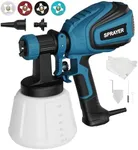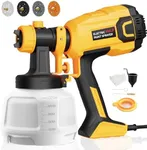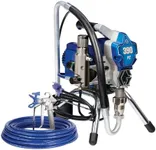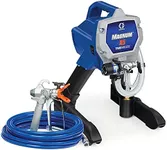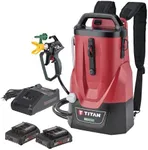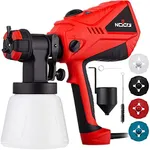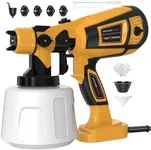Buying Guide for the Best Electric Paint Sprayers
Choosing the right electric paint sprayer can make your painting projects faster, easier, and more professional-looking. The key to finding the best fit for you is understanding the different specifications and how they align with your specific needs. Here are the main specs to consider when selecting an electric paint sprayer.PowerPower in electric paint sprayers is measured in watts or horsepower. This spec is important because it determines the sprayer's ability to handle thicker paints and cover larger areas efficiently. Lower power (around 300-500 watts) is suitable for small projects like furniture or crafts. Medium power (500-800 watts) is good for medium-sized projects like rooms or fences. Higher power (800+ watts) is ideal for large projects like exterior walls or large surfaces. Choose the power level based on the size and type of your projects.
Flow RateFlow rate indicates how much paint the sprayer can apply per minute, usually measured in gallons per minute (GPM). This is important because it affects how quickly you can complete a project. A lower flow rate (0.1-0.2 GPM) is suitable for detailed work and small projects. A medium flow rate (0.2-0.4 GPM) is good for medium-sized projects. A higher flow rate (0.4+ GPM) is ideal for large projects where speed is essential. Consider the size of your projects and how quickly you want to complete them when choosing the flow rate.
Nozzle SizeNozzle size determines the width and pattern of the paint spray. This is important because different projects require different spray patterns for optimal coverage and finish. Smaller nozzles (0.009-0.013 inches) are best for fine detail work and thin materials like stains and lacquers. Medium nozzles (0.013-0.017 inches) are suitable for general-purpose use with most paints. Larger nozzles (0.017-0.021 inches) are ideal for heavy coatings like latex paint. Choose the nozzle size based on the type of paint you will use and the detail required for your projects.
Hose LengthHose length determines how far you can move around without having to move the sprayer unit. This is important for convenience and efficiency, especially in larger projects. Short hoses (up to 15 feet) are suitable for small, confined areas. Medium hoses (15-25 feet) are good for medium-sized rooms or areas. Long hoses (25+ feet) are ideal for large projects where you need more mobility. Consider the size of your work area and how much mobility you need when choosing the hose length.
WeightWeight affects the ease of handling and maneuverability of the sprayer. This is important because a lighter sprayer is easier to use for extended periods, while a heavier sprayer may be more stable but harder to move. Lightweight sprayers (under 10 pounds) are ideal for small projects and detailed work. Medium-weight sprayers (10-20 pounds) are suitable for general use. Heavyweight sprayers (20+ pounds) are best for large projects where stability is more important than portability. Choose the weight based on how long you will be using the sprayer and your ability to handle it.
AdjustabilityAdjustability refers to the ability to control the spray pattern, flow rate, and pressure. This is important because it allows you to customize the sprayer's performance to match the specific requirements of your project. Sprayers with basic adjustability are suitable for simple, straightforward projects. Those with moderate adjustability offer more control for varied projects. High adjustability is ideal for professional use or complex projects requiring precise control. Consider the complexity of your projects and your need for customization when choosing the level of adjustability.
